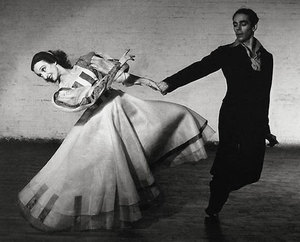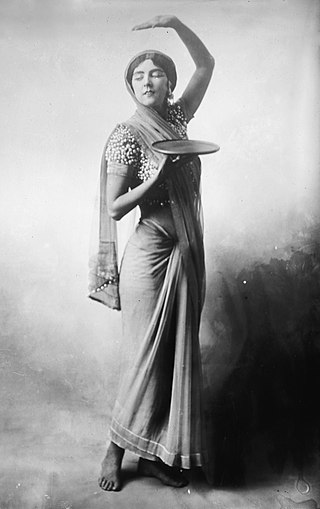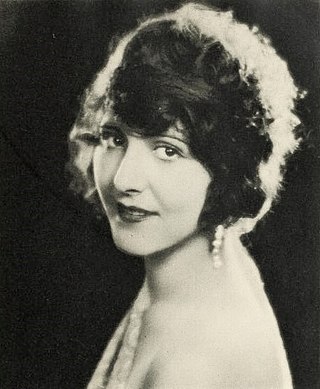Related Research Articles

Ruth Crawford Seeger was an American composer and folk music specialist. Her music was a prominent exponent of the emerging modernist aesthetic and she became a central member of a group of American composers known as the "ultramoderns". Though she composed primarily during the 1920s and 1930s, Seeger turned towards studies on folk music from the late 1930s until her death. Her music influenced later composers, particularly Elliott Carter.

No, No, Nanette is a musical comedy with lyrics by Irving Caesar and Otto Harbach, music by Vincent Youmans, and a book by Otto Harbach and Frank Mandel, based on Mandel's 1919 Broadway play My Lady Friends. The farcical story involves three couples who find themselves together at a cottage in Atlantic City, New Jersey, in the midst of a blackmail scheme, focusing on a young, fun-loving Manhattan heiress who naughtily runs off for a weekend, leaving her unhappy fiancé. Its songs include the well-known "Tea for Two" and "I Want to Be Happy".

Doris Batcheller Humphrey was an American dancer and choreographer of the early twentieth century. Along with her contemporaries Martha Graham and Katherine Dunham, Humphrey was one of the second generation modern dance pioneers who followed their forerunners – including Isadora Duncan, Ruth St. Denis, and Ted Shawn – in exploring the use of breath and developing techniques still taught today. As many of her works were annotated, Humphrey continues to be taught, studied and performed.

Ruth St. Denis was an American pioneer of modern dance, introducing eastern ideas into the art and paving the way for other women in dance. She was inspired by the Delsarte advocate Genevieve Stebbins. St. Denis was the co-founder in 1915 of the American Denishawn School of Dancing and Related Arts. She taught notable performers including Martha Graham and Doris Humphrey. In 1938, she founded the pioneering dance program at Adelphi University. She published several articles on spiritual dance and the mysticism of the body.

Katherine Mary Dunham was an American dancer, choreographer, anthropologist, and social activist. Dunham had one of the most successful dance careers of the 20th century and directed her own dance company for many years. She has been called the "matriarch and queen mother of black dance."

Elizabeth Marie Tallchief was an American ballerina. She was considered America's first major prima ballerina. She was the first Native American to hold the rank, and is said to have revolutionized ballet.

Ruth Etting was an American singer and actress of the 1920s and 1930s, who had over 60 hit recordings and worked in stage, radio, and film. Known as "America's sweetheart of song", her signature tunes were "Shine On, Harvest Moon", "Ten Cents a Dance" and "Love Me or Leave Me".

Raisin is a musical with music by Judd Woldin, lyrics by Robert Brittan, and a book by Robert Nemiroff and Charlotte Zaltzberg. It is an adaptation of the Lorraine Hansberry play A Raisin in the Sun; the musical's book was co-written by Hansberry's husband, Robert Nemiroff.

Ruth Page was an American ballerina and choreographer, who created innovative works on American themes.

Patsy Ruth Miller was an American film actress who played Esméralda in The Hunchback of Notre Dame (1923) opposite Lon Chaney.
Hans Crocker was an American lawyer and Wisconsin politician.
Ruth Van Sickle Ford was an American painter, art teacher, and owner of the Chicago Academy of Fine Arts. She credited artists George Bellows, who influenced her interest in social realism, and John Carlson, who founded the School of Landscape Painting in Woodstock, New York, with helping her to develop her talent. She traveled and made paintings in the United States, Caribbean and South America. An award-winner, her works are in many permanent public and private collections. A book has been written about her entitled Warm Light, Cool Shadows: The Life and Art of Ruth Van Sickle Ford.
Ruth Hardy Funk was the seventh general president of the Young Women organization of the Church of Jesus Christ of Latter-day Saints from 1972 to 1978.
Edith Allard was an American ballerina.
Margot Grimmer rose to prominence as a dancer in several companies, including the Lyric Opera Ballet, the Ruth Page International Ballet, the New York City Ballet, and the Ballet Russe de Monte Carlo. She studied ballet as a child in Chicago, and was among 50 from 3,000 applicants selected for the children’s ensemble of the New York City Ballet’s Chicago production of George Balanchine’s Nutcracker at the Opera House. At age 14, she danced professionally in Broadway musicals at the Kansas City Starlight Theatre and continued at the St. Louis Municipal Theatre and Music Theater in Highland Park. After high school, Grimmer’s career flourished. In 1962, she appeared with Ruth Page’s Chicago Opera Ballet in the American debut of Russian defector superstar Rudolf Nureyev at the Brooklyn Academy of Music. In 1965, she danced a principal role in the Lyric Opera of Chicago’s production of Carmina Burana at the Opera House. From 1965-1968, she performed in the International Ballet’s Nutcracker, starring Erik Bruhn, Carla Fracci, Henning Kronstam and Kirsten Simone, at McCormick Place and the Opera House. From 1965-1968, she gave lecture-demonstration performances in ballet and modern dance, under a federal grant from the National Endowment for Arts, for the War On Poverty’s Cultural Enrichment program in Chicago’s inner city schools. In 1967, she was featured in the experimental dance movie Statics, which won awards in cinematography and art direction at International Film Festivals. On off-seasons, she attended Northwestern University, majoring in acting and English Literature.
Ruth Pryor (1906-2001) was a Chicago ballet dancer and instructor, and the first American ballerina to dance the role of the Swan Queen in Swan Lake, in 1930. She was known for "her feat of whirling thirty-six times a minute on her toes," according to the Purple Parrot of Northwestern University.
Kilbourn or Kilborn may refer to:
Ruth Miriam DeYoung Kohler was a journalist and women's rights advocate.
Joan Kilbourn was an American microbiologist and educator.
Annelisa Marcelle Kilbourn was a British conservationist, veterinarian and wildlife expert. She worked in Malaysia guarding free-ranging elephants and orangutans and protecting Sumatran rhinoceros and in Madagascar studying ring-tailed lemurs. Kilbourn went on to work at the Lincoln Park Zoo and Shedd Aquarium in Chicago. In Gabon, she established that wild gorillas were susceptible to death of the Ebola virus and could be transmitted to humans through hunting and eating infected species. In 2003, Kilbourn was posthumously elected to the Global 500 Roll of Honour by the United Nations Environment Programme.
References
- ↑ "Ruth Kilbourn Papers, ca. 1947-1949". Explore Chicago Collections. Retrieved 2023-09-26.